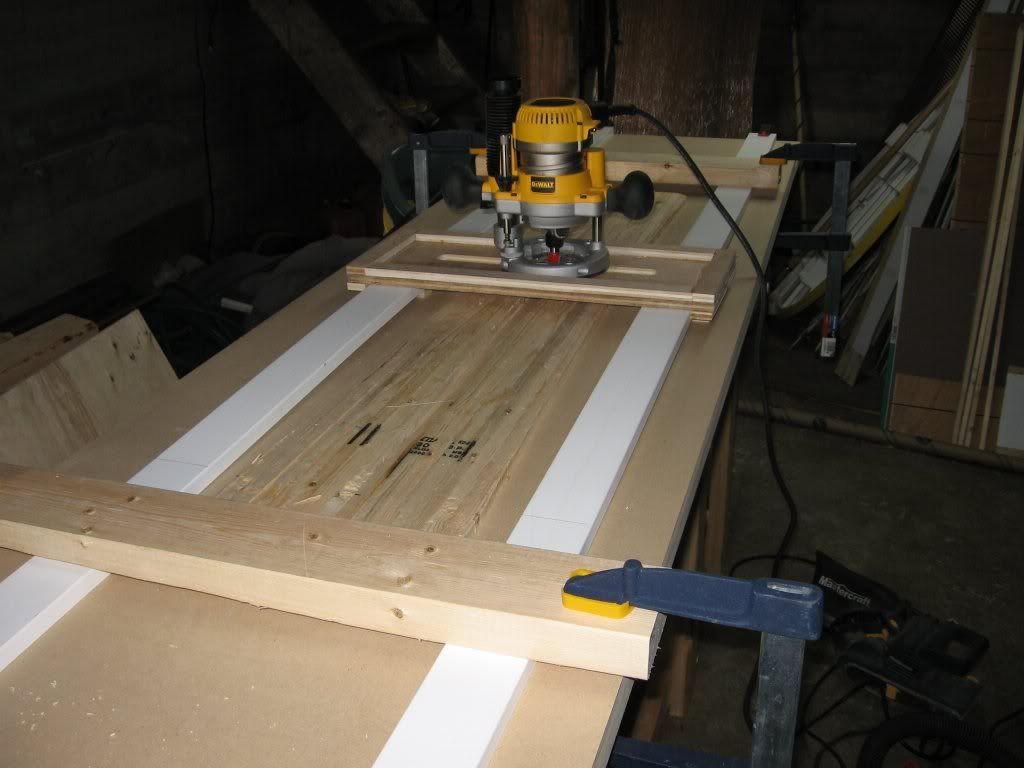Page 1 of 2
Anyone have any tips on how to make one of these?
Posted: Sat Feb 08, 2014 3:07 pm
by backyardskier

From what I see which is the obvious it is a metal bar that seems to have threaded holes for bolts. The bolts go through the table and the height is adjusted by tighten or loosen the bolt. I think at least that is how it works. I have done some searches for a metal bar such as the one in the picture but alas I can not find any, which makes me think that it is home made. So if any of you have any tips one how to make on of these that would be greatly appreciated.
Posted: Sat Feb 08, 2014 3:55 pm
by falls
stiff table top
weld some all thread pieces perpendicular to a tubular rail at even intervals.
drill holes in table top and use nut able and below table to adjust height and keep everything rigid.
Either count turns of nut on thread below table or more likely just adjust and measure til the two rails are the same height at each location.
Normal router table sled then to run on top of the rails
Posted: Mon Feb 10, 2014 6:43 am
by Dimitar
This is how we do it.


The metal profiles are just drilled. No welding. It looks adjustable, but it is not so easy. You will need at least 3-4 hours to adjust the height as you want it, because it is point of 0.1 mm...
Let me know, if you need more details about it.
Good luck!
Dimitar
Posted: Mon Feb 10, 2014 10:09 am
by sammer
I wouldn't use MDF for a sled, the stuff is a noodle.
My first sled was made out of baltic birch and was still pretty flexy.
1/4mm+ if I put a bit of weight on the router during a pass.

The latest one is boxed MDF and maple still a bit of deflection but I have to push pretty darn hard to make it happen. no pics sorry.
sam
Posted: Mon Feb 10, 2014 11:34 am
by twizzstyle
Sam, why haven't you just made a sled out of steel?
Posted: Mon Feb 10, 2014 3:42 pm
by sammer
twizzstyle wrote:Sam, why haven't you just made a sled out of steel?
Was thinking Carbon fiber ;-)
Steel's too heavy!
sam
Posted: Mon Feb 10, 2014 5:17 pm
by MadRussian
sammer wrote:
Steel's too heavy!
sam
So what? If bridge heavy you don't have to hold it down. imo heavy is good
Posted: Thu Feb 13, 2014 1:25 am
by Dimitar
Posted: Sat Feb 15, 2014 2:18 pm
by Richuk
I suspect there is a good reason to use round bar.
Posted: Mon Feb 17, 2014 2:50 pm
by PTTR
We use a similar construction but with wooden rails. Remember to measure the hight from the sled instead of the rails!
strangeflexingskisnomore.
Posted: Mon Feb 17, 2014 3:01 pm
by twizzstyle
Richuk wrote:I suspect there is a good reason to use round bar.
Why do you think that?
If it were me - and I tend to way over-build things - I'd use some kind of rectangular bar and I'd skin the top with a strip of nylon

And if you really wanted some tight tolerances, you could use two wedges stacked on top of each other at each height station, so as you tighten a horizontally oriented bolt, the wedge on top would slide upwards... this might get expensive, but sounds like a fun project!
Posted: Mon Feb 17, 2014 4:38 pm
by skimann20
Not that I would ever argue with Twizz because the guy has mad eng skills...
maybe if you put bearings in the bridge it will allow for less friction and thus allow it to move easier. by having round stock then you could use bearings that would cup the bar, this would allow for tighter tolerances. my $0.02.
Posted: Mon Feb 17, 2014 5:41 pm
by Richuk
I was thinking about it in terms of the cross-section. Square bar creates four points of contact with the sled, round bar creates two. So if you are pushing for fine tolerences, then a round bar will be more tolerant of any manufacturing faults that result in twist. The cause could be the angles of the thread at the end of the bolt or the positions of the bolts relative to each other - not in line, or both.
I also wondered whether round bar helps to ensure a continous curve. I would imagine that square bar, heavily anchored, is more prone to creating a point to point profile. Anyway, just thoughts.
Posted: Mon Feb 17, 2014 5:54 pm
by twizzstyle
ahh yeah, no that's actually a really good point. So maybe round bar for the rails, and then a strip of nylon on either side of the sled as the sliding surface. Drilling/tapping of round bar will be much more difficult, so welding some threaded rod on would be much easier in that case, as long as you can keep things nice and square.
Posted: Mon Feb 17, 2014 11:11 pm
by PTTR
AAAAAAAHHHHHhhhh
you are so much over thinking this.
wood works fine. steel does too. My sled is made of coated plywood and I use a candle to wax the gliding parts. super smooth super précis as long as you take your time when changing it. I have a bolt every 15 cm and a vacuum hold down. If I would only do adult skis I would have less bolts - like in the picture from the video.








